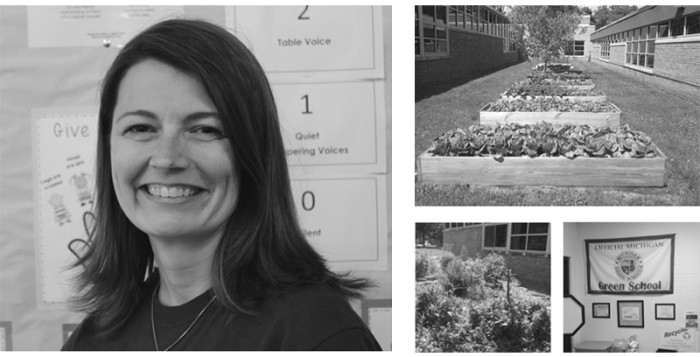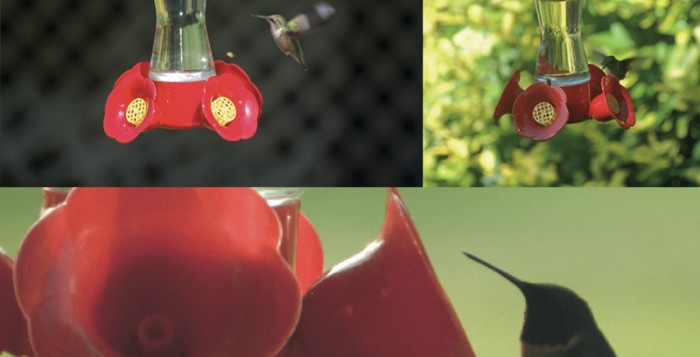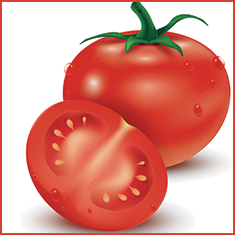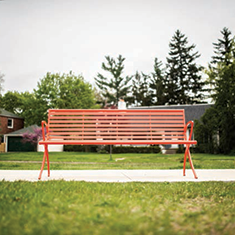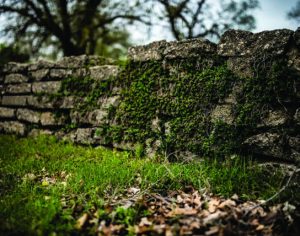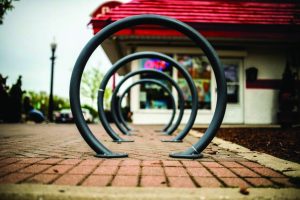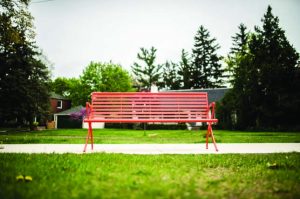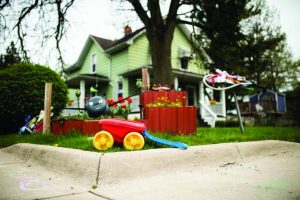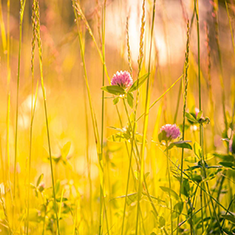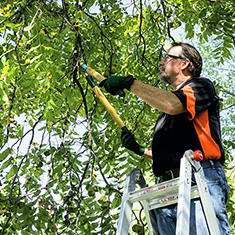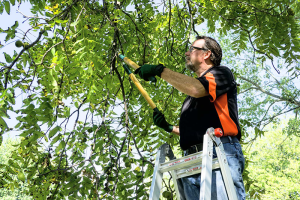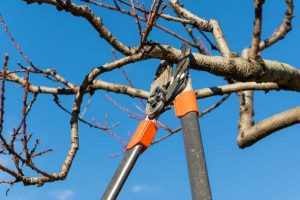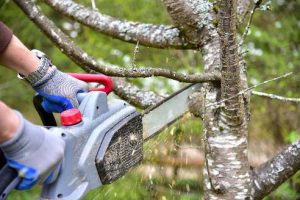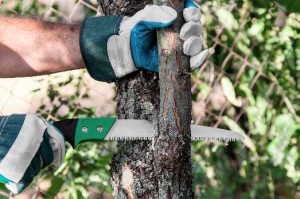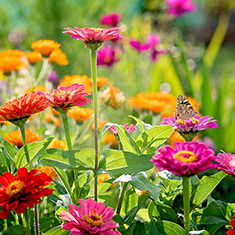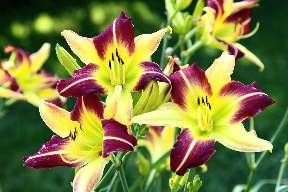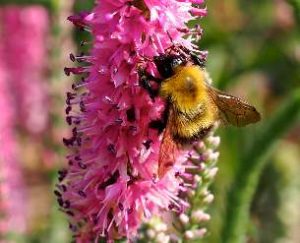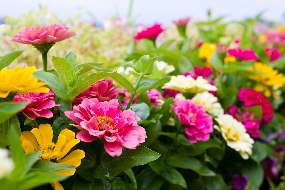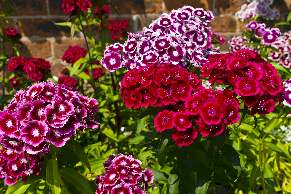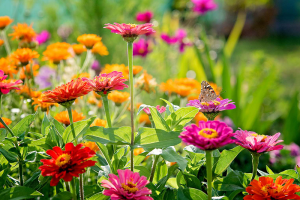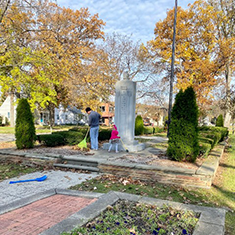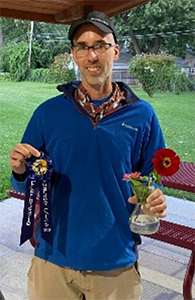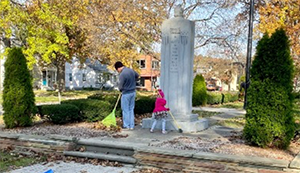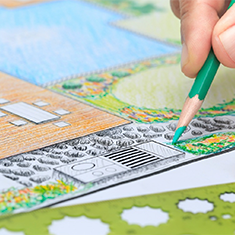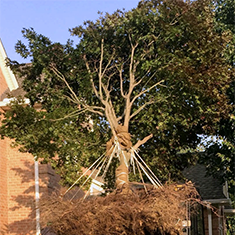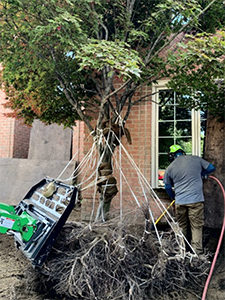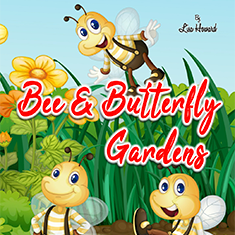By Ryan R. Ennis
ACROSS NORTH AMERICA, ALARMS SHOULD BE SOUNDING ABOUT WHAT THE FUTURE HOLDS for the creatures who fertilize our flowers and crops. Environmentalists at Pennsylvania State’s Center for Pollinator Research report that beekeepers have been losing significant amounts of their colonies each year. Conservationists at the Center for Biological Diversity stress that Monarch butterflies are
now hovering near extinction. And scientists at the Cornell Lab of Ornithology declare that many bird species are also endangered. All of this seems to imply impending doom for our natural world.
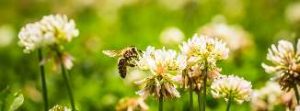 In response to the crisis, the researchers are also looking at the reasons why wildlife populations are decreasing. Some of their investigations show that a major contributor is the expanse of traditional lawns in our cities. When lawns consist of just sod or grass, they create what is called a “monoculture,” or the growing of a single plant. Acting as a “dead zone,” the lack of diverse vegetation disrupts the natural food webs. As birds swoop down over the grass, they frequently find no caterpillars to snatch and feed to their babies. Despite roaming for hours and miles, butterflies and
In response to the crisis, the researchers are also looking at the reasons why wildlife populations are decreasing. Some of their investigations show that a major contributor is the expanse of traditional lawns in our cities. When lawns consist of just sod or grass, they create what is called a “monoculture,” or the growing of a single plant. Acting as a “dead zone,” the lack of diverse vegetation disrupts the natural food webs. As birds swoop down over the grass, they frequently find no caterpillars to snatch and feed to their babies. Despite roaming for hours and miles, butterflies and
bees often fail to come across any clover or milkweed to feast on. With so little nutrients available, it’s no wonder that birds and insects are dying off.
Regular lawns can be detrimental to the environment in other ways. Possessing short root structures,
both turf and sod lack the ability to soak up the water from heavy downpours. The surplus water runs off our lawns, fills up the storm drains, and puts unnecessary stresses on our infrastructures. This same rainwater flooding our drains and sewers oftentimes contains the fertilizes we use to treat our lawns.
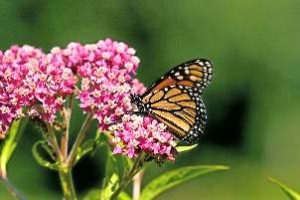 Eventually, the chemicals end up in our rivers and lakes, resulting in an overabundance of algae growing in them. By blocking out the sun and absorbing all the oxygen near the surface, the massive algae blooms diminish the lifecycles of the creatures and plants whose homes are our waterways. Humans are affected by the invasive plant as well. If we happen to canoe or kayak across a stream full of bacteria-ridden algae, we risk exposure to the harmful toxins being released in the air.
Eventually, the chemicals end up in our rivers and lakes, resulting in an overabundance of algae growing in them. By blocking out the sun and absorbing all the oxygen near the surface, the massive algae blooms diminish the lifecycles of the creatures and plants whose homes are our waterways. Humans are affected by the invasive plant as well. If we happen to canoe or kayak across a stream full of bacteria-ridden algae, we risk exposure to the harmful toxins being released in the air.
LANDSCAPING OPTIONS THAT HELP WILDLIFE
AS A WAY OF HELPING NATURE TO REBOUND, Ferndale Garden Club President Dominic Scappaticci proposes that we “rethink what a traditional lawn should look like.” For decades, owning a house or condo with a lush lawn has been the benchmark in suburbia. A well- maintained yard often communicates to others that we care about ourselves, our neighbors, and our communities. It also provides appropriate places where dogs can walk and sniff, children can play, and outdoor parties can be hosted. To design these spaces, Scappaticci says that we don’t have to lay down sod or plant only grass seed. Instead, we help the environment by choosing to create a bee lawn in our yards.
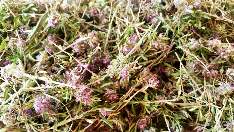 “Bee lawns,” explains Scappaticci, “are a mix of lawn grass and low-growing plants that attract pollinators.” Some of the plants that entice bees include clover, creeping thyme, and the herb called self-heal. Although these plants all flower, the blooms remain small enough to survive the lawnmower blade. Since bee lawns can be trimmed, we can still use them for recreation. Another advantage of bee lawns is that they are able to endure significant fluctuations in the weather. Perhaps best of all, they require limited watering and no chemicals to stay green.
“Bee lawns,” explains Scappaticci, “are a mix of lawn grass and low-growing plants that attract pollinators.” Some of the plants that entice bees include clover, creeping thyme, and the herb called self-heal. Although these plants all flower, the blooms remain small enough to survive the lawnmower blade. Since bee lawns can be trimmed, we can still use them for recreation. Another advantage of bee lawns is that they are able to endure significant fluctuations in the weather. Perhaps best of all, they require limited watering and no chemicals to stay green.
“A lot of research concerning bee lawns,” reveals Scappaticci, “has been conducted by
scientists at the University of Minnesota. They actually studied what kinds of seed mixes work best for withstanding the mower and people walking on them.” These mixes have been made available for the public purchase through commercial landscaping companies and online vendors, such as Twin Seed and Outsidepride Seed Source.
Installing a natural meadow is another environmentally-conscious option for us. “Natural meadows are a mix of native grasses and native meadow plants,” explains Scappaticci, “that are grown to full height. Thus, they are much taller than bee lawns.” This type of landscape has an even greater impact on our ecosystems. The taller plants provide habitats for insects to lay eggs and com-plete their lifecycles; as well as places for birds to feed, take shelter, and locate nesting materials.
One drawback to natural meadows is that the high vegetation makes it poorly suited for recreational activities. Another is the slight risk of ticks ending up in the tall grasses, so we shouldn’t let our children or dogs wander through them without taking precautions.
SELECTING & NURTURING NATIVE PLANTS
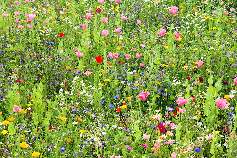 “BEFORE TRYING TO ESTABLISH A NATURAL MEADOW, know the soil,” Scappaticci advises. “It will
“BEFORE TRYING TO ESTABLISH A NATURAL MEADOW, know the soil,” Scappaticci advises. “It will
determine the types of grass and perennials that should be planted.” For drier or sandy Michigan ground, the following non-invasive grasses will grow well: prairie dropseed, Canada wild rye, and switchgrass. For damper Michigan soil, the following will work better: sedges, swamp milkweed, and Joe
Pye weed. Some flowering perennials that attract pollinators and can be mixed with the grasses are milkweed, purple coneflowers, blazing star, and native asters. “Plants appropriate for meadows,” he adds, “need full-sun exposure.”
If we plan to grow a bee lawn, “it can be done simply by overseeding,” says Scappaticci. In the spring, this involves thoroughly raking our yards, then sprinkling a bee lawn mixture over the grass, with heavy seed concentrations on any bare patches. After a few rainfalls, the low-growing grass and flowering plants that bees love will begin to expand across the lawn. To maintain a bee lawn on our property, we will only need to mow the yard every few weeks and possibly reseed in some areas the following year.
Unlike a bee lawn, a natural meadow requires more thought, labor, and time to cultivate. According to Scappaticci, the best technique is to “start with a clean slate.” That means removing all the existing vegetation in the location where the meadow will go in early spring. To smother any regrowth, the soil
should be covered with either weighted-down sheets of card- board or black plastic tarps. In some instances, the tarps are preferred because they absorb sunlight and transfer intense heat into the soil, which kills off the seeds from the old vegetation.
After a month or so, we can take off the covers and then aerate the soil. To prevent any weeds from
invading, Scappaticci recommends immediately putting in an annual crop of clover or rye grass. In between the clover or rye grass is where meadow-flourishing perennials and native grasses will be planted. By the next year, the size of the native plants will increase in all directions to fully occupy the area.
If we don’t have weeks to devote to the project, there’s another method that takes less time. The steps to this other method are letting our grass grow long in a particular area, digging out any invasive weeds by hand, and then planting taller-growing perennials throughout the section. Since the original vegetation was never choked out, the second approach gives weeds the opportunity to come back more frequently.
Other than monitoring the meadows for weeds and other invasive plants, we most likely will find the upkeep of them to be relatively simple. A common city ordinance requires that property owners register their planned natural landscapes to avoid receiving a ticket for out-of-control vegetation. Another typical regulation is that the property owners must also retain a border of mowed lawn surrounding it. The width of the border should span several feet or more to ensure that our neighbor’s views are unobstructed as they pull in or back out of their driveways.
At the end of the growing season, Scappaticci says that we should “cut down some of the grass and perennials sections, which allows seeds to set in the soil for birds to collect and eat.” One portion of the meadow should remain standing to serve as a refuge for wildlife during the winter. Each year, he advises “alternating which section is left untouched” over the winter so that the varying plants and their seeds can provide food and shelter for different pollinators.
As a closing thought, he tells us not to be too hard on ourselves for any blunders in designing or caring for natural landscapes: “Simply try again. Even planting one native plant at a time will go a long way” to enhance nature in our communities.
OTHER SOURCES OF INFORMATION
IF WE NEED ADDITIONAL RESOURCES to help us under- stand how natural landscapes work, we can read the ecologist Doug Tallamy’s books on eco-friendly approaches to gardening. His books can be checked out at most public libraries.
Another option available is visiting the natural meadows that have been developed at both Palmer Park and Callahan Park in Detroit. Volunteers at the Detroit Bird City project look after these landscapes and encourage the public to stop by and take a stroll so that they can see the different native plants and how they draw a diversity of bird life.
To gain more knowledge on conservation, we can also join our local garden clubs, or become members of our city’s park & recreation and sustainability commissions.
Lastly, there is uniting with the Homegrown National Park movement. Its philosophy states that if everyone took a portion of their yard and converted it into a meadow, the combined sections would be larger than our national parks and therefore have a significant impact on the environment. Containing extensive information on native plants, the organization’s website is www.homegrownnationalpark.org.
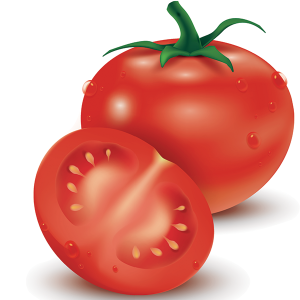 THE URBAN FARMING TREND CAUGHT ON DECADES AGO THROUGHOUT OUR COUNTRY…
THE URBAN FARMING TREND CAUGHT ON DECADES AGO THROUGHOUT OUR COUNTRY…
